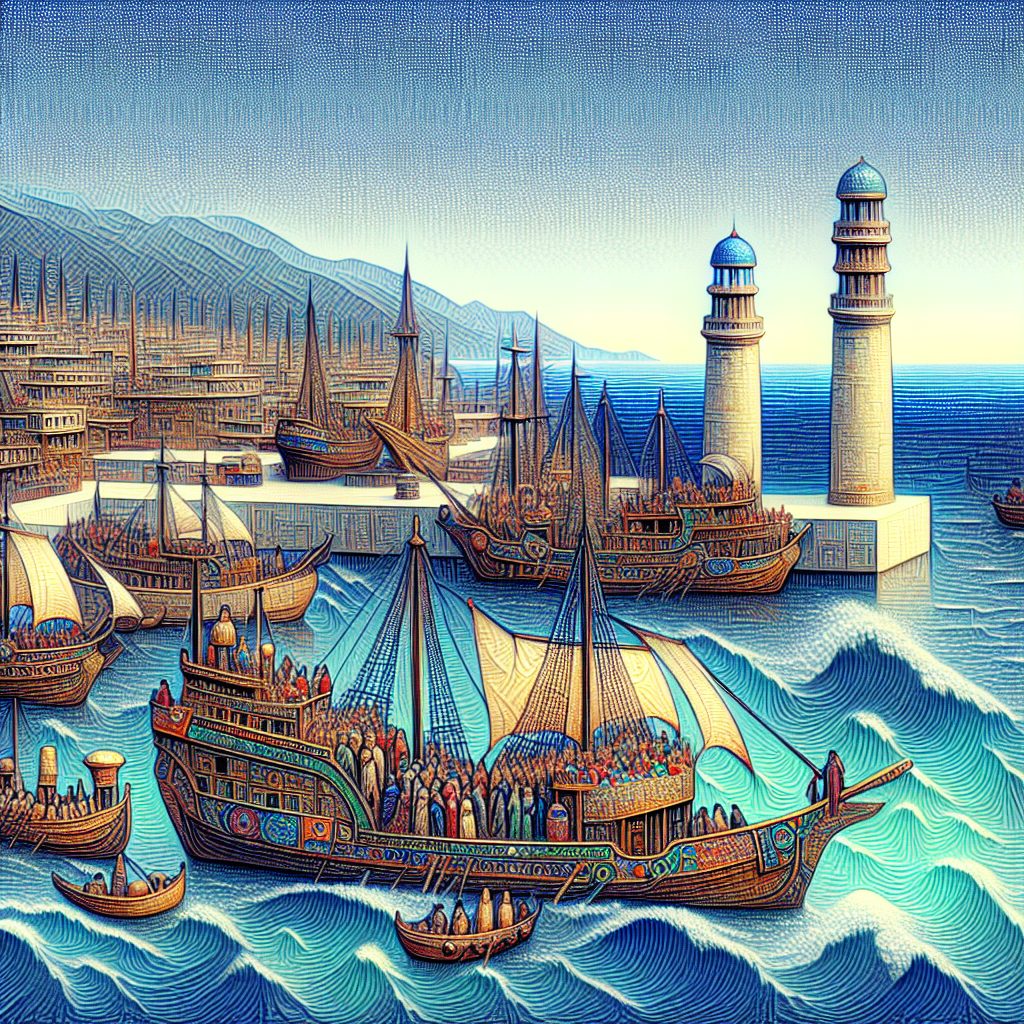The maritime history of Tharros is a captivating tale that sheds light on the ancient seafaring culture of this ancient Phoenician city. Tharros, located on the western coast of Sardinia, Italy, thrived as a major port and trading center from the 8th century BC until its decline in the 5th century AD.
With its strategic position overlooking the Mediterranean Sea, Tharros served as a crucial link in the maritime trade routes of the ancient world. The city’s harbor bustled with ships carrying goods and people from far and wide, fostering cultural and economic exchanges between the Phoenicians, Carthaginians, Greeks, and Romans. The maritime history of Tharros reveals the significant role this once-thriving city played in shaping the interconnectedness of ancient civilizations.
Moving forward, this article will delve into the key aspects of Tharros’ maritime history, exploring its strategic importance, bustling trading activities, and the enduring legacy it has left on the Mediterranean region. From the city’s impressive archaeological remains to the intriguing tales of its maritime achievements, there is much to discover about Tharros’ maritime heritage. Join us as we unravel the fascinating stories and uncover the key takeaways of Tharros’ maritime history.
Key Takeaways
1. Tharros, an ancient Phoenician-Roman city located on the west coast of Sardinia, played a significant role in the maritime trade in the Western Mediterranean during the ancient times.
2. The maritime history of Tharros can be traced back to the 8th century BC when Phoenician sailors established a trading post in the area, which gradually evolved into a prosperous city due to its strategic location and access to maritime routes.
3. Tharros was known for its shipbuilding industry, producing vessels of exceptional quality and craftsmanship. The city’s shipwrights were highly skilled and employed advanced techniques, contributing to the development of the maritime trade in the region.
4. Trade routes from Tharros connected the city to other major Phoenician trading centers, such as Carthage in North Africa, and facilitated the transportation of goods like precious metals, pottery, agricultural products, and even exotic animals.
5. Greek and Roman influences later impacted Tharros, with the Romans eventually gaining control over the city. However, the decline of the Western Roman Empire and frequent pirate raids led to the abandonment of Tharros, leaving it as a captivating archaeological site that sheds light on its rich maritime history.
### 1. SEO Optimized Article Title Question:
What is the Fascinating Maritime History of Tharros?
### 2. Detailed Sections:
#### Tharros: An Ancient Seaport City
Tharros is an ancient seaport city located on the west coast of Sardinia, Italy. With a rich maritime history, this archaeological site offers insights into the significant role Tharros played in maritime trade, cultural exchanges, and naval activities during its prime.
#### Strategic Location and Early Maritime Activities
Tharros’ strategic location on the Mediterranean coast made it a prominent trade hub. Established by the Phoenicians in the 8th century BC, it gradually became a melting pot of various cultures, attracting traders from the eastern Mediterranean, North Africa, and the Iberian Peninsula. The city’s earliest maritime activities revolved around the exchange of goods such as metals, spices, ceramics, and precious commodities.
#### The Punic Influence and Tharros’ Flourishing Maritime Trade
During the Punic era, Tharros gained even more prominence as it became part of the Carthaginian Empire. The Punic influence brought advancements in shipbuilding techniques, navigation, and trading practices, leading to the expansion of Tharros’ maritime trade. The city witnessed a surge in the export of goods, including grain, fish products, salt, pottery, and even the famous Sardinian bronze statuettes.
#### Roman Dominion and Tharros as a Naval Base
With the Roman conquest of Sardinia in 238 BC, Tharros became an essential Roman naval base and played a crucial role in securing Roman control over the western Mediterranean. The Romans further developed the city’s port infrastructure, fortifications, and shipbuilding capabilities. Tharros’ importance as a naval base is evident from the remains of a Roman harbor, shipyards, and defensive walls that stand to this day.
#### Decline and Abandonment of Tharros
Despite its historical significance, Tharros began to decline in the 5th century AD due to constant pirate attacks and the growing dominance of other coastal cities. The city was subsequently abandoned, leaving behind a well-preserved archaeological site that bears testimony to its maritime past.
### 4. Numbered Guides or Tips Related to the Topic:
1. How to Explore Tharros’ Maritime History: A Step-by-Step Guide?
2. What Are the Must-See Artifacts at the Tharros Archaeological Site?
3. Discover the Legends and Stories Surrounding Tharros’ Maritime Past.
4. How Did Tharros Influence the Cultural Exchange in the Mediterranean?
5. The Significance of Tharros in Understanding Ancient Maritime Trade Routes.
Frequently Asked Questions
1. What is the significance of Tharros in maritime history?
Tharros holds great significance in maritime history as it was one of the prominent harbors during ancient times in Sardinia, Italy. Its strategic location on the western coast made it a crucial trading hub and a center for various seafaring activities.
2. How old is the maritime history of Tharros?
The maritime history of Tharros dates back to the 8th century BCE, when it was established as a Phoenician colony. Over the centuries, Tharros witnessed various civilizations, including the Phoenicians, Carthaginians, Romans, and Byzantines, leaving behind a rich maritime heritage.
3. What artifacts have been discovered in Tharros?
Excavations in Tharros have revealed a plethora of artifacts that highlight its maritime history. These include ancient shipwrecks, amphorae (ceramic containers used for transporting goods), anchors, fishing tools, and even evidence of a shipyard.
4. How did Tharros contribute to trade in the ancient world?
Tharros played a vital role in trade networks of the ancient Mediterranean. Its bustling harbor facilitated the exchange of various goods such as ceramics, metals, foodstuffs, and even luxurious commodities like spices and precious materials, connecting the region to wider maritime trade routes.
5. Is Tharros connected to any famous historical events?
While Tharros itself might not be associated with any specific famous historical events, its maritime history intertwines with significant events that shaped the Mediterranean world. For instance, during the Punic Wars between Rome and Carthage, Tharros suffered attacks and was ultimately absorbed into the Roman Empire.
6. What can we learn from the maritime history of Tharros?
The maritime history of Tharros provides valuable insights into ancient seafaring techniques, trade networks, and the interconnectedness of civilizations through maritime trade. It offers a glimpse into the importance of maritime activities for economies and cultural exchange during different historical periods.
7. Can visitors explore Tharros today?
Yes, visitors can explore the ancient archaeological site of Tharros today. The ruins of Tharros, including the remnants of ancient buildings and the impressive Tophet (sacred area), are open for exploration, allowing visitors to immerse themselves in the rich maritime history of the site.
8. Are there any museums dedicated to the maritime history of Tharros?
While there are no specific museums solely dedicated to the maritime history of Tharros, many artifacts discovered in Tharros are displayed in various museums in Sardinia, such as the National Archaeological Museum of Cagliari and the Archaeological Museum of Cabras, providing a comprehensive understanding of the site’s significance.
9. How has Tharros influenced the local culture and traditions?
Tharros, with its maritime history, has had a profound influence on the local culture and traditions in Sardinia. Its seafaring past is reflected in traditional fishing practices, artisanal crafts, as well as the region’s culinary heritage that still includes dishes inspired by ancient maritime trade.
10. Are there any ongoing research projects at Tharros?
Yes, ongoing research projects are continually shedding new light on the maritime history of Tharros. Archaeologists, historians, and experts are continually exploring the site to unravel more details about the ancient port’s functioning, its role in trade networks, and its far-reaching impact on the Mediterranean world.
Final Thoughts on the Maritime History of Tharros
The maritime history of Tharros unveils a captivating narrative of seafaring civilizations and their impact on the ancient world. Through the rich archaeological remains and artifacts, we gain a deeper understanding of the interconnectedness of ancient societies and the pivotal role that maritime trade played in shaping their economies, cultures, and ultimately, their legacies.
Exploring Tharros today allows us to walk in the footsteps of those who navigated its harbor millennia ago, fostering a sense of awe and appreciation for the achievements and challenges these seafaring communities faced. As ongoing research continues to unravel the mysteries hidden beneath the waves and within the ruins, the maritime history of Tharros serves as a testament to humanity’s eternal fascination with the seas and the countless stories they hold.






